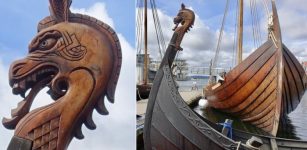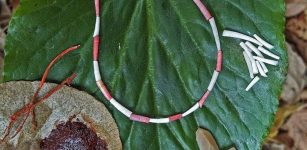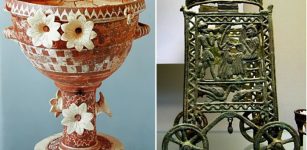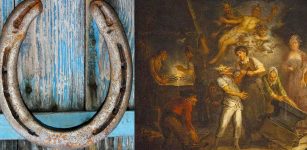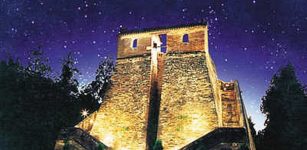Early Christian Landmark – Re-Evaluation Of Its Architecture And Practices
Conny Waters - AncientPages.com - A new study challenges the long-held belief that an ancient Syrian building was a domestic "house church."
Since its discovery by modern researchers a century ago, an ancient structure commonly known as the “Christian building” has become widely considered the cornerstone of early Christian architecture.

The ancient structure known as the “Christian building” has long been considered the only example of a “house church,” or domestic space renovated for Christian worship. (Photo courtesy of Yale University Art Gallery)
The building in question, located in the ancient Roman garrison town of Dura-Europos in present-day eastern Syria, was constructed circa 232 C.E. It holds significant historical importance as the sole known example of a "house church," also referred to as a domus ecclesiae. This structure represents a unique adaptation of a domestic space, modified to serve as a place of worship for early Christians.
The existence of this house church provides valuable insight into the practices of early Christianity during a period when open religious expression was potentially dangerous. Historical evidence suggests that Christians of this era faced the risk of persecution for publicly practicing their faith. As a result, the conversion of private residences into discreet places of worship became a practical solution for early Christian communities.
A new study in the Journal of Roman Archaeology challenges the conventional belief about the building's purpose. It argues that after renovations, the structure served religious functions rather than domestic ones. This finding questions the entire concept of the domus ecclesiae.
Camille Leon Angelo, a Yale Ph. D. candidate, argues that the building was likely not a house church at all. This conclusion is based on comparing its architectural features with other domestic structures in Dura-Europos homes and analyzing how renovations affected interior light flow.
“Dialogues within the academy as well as in popular culture give the impression that Christians had, prior to Emperor Constantine, gathered and worshipped in pseudo-domestic spaces,” said Leon Angelo, who is part of Yale’s Department of Religious Studies.
“But if this is the only securely dated example we have, and it wasn’t in fact particularly or even somewhat domestic, then why do we keep up that perception?”
‘How domestic was it?’
A 10-year excavation of Dura-Europos in the 1920s-30s by Yale and French Academy scholars unearthed a Christian building, synagogue, and Mithraeum. Their journals, photos, and artifacts are archived at Yale University Art Gallery.
The structure, initially considered a private home, was adapted for Christian worship around 234 C. E. Scholars view it as a domus ecclesiae, bridging the gap between New Testament-era house churches and Constantinian basilicas.
The site remained active until approximately 254-256 C.E. During this period, the Sasanians laid siege to the city, prompting the Romans to reinforce the western fortification wall. This defensive measure involved constructing a substantial earthen embankment, which inadvertently sealed off numerous buildings. Following the city's conquest and subsequent abandonment, the residual embankment played a crucial role in the preservation of these structures.
Over the centuries, this unintended consequence of wartime fortification resulted in the exceptional conservation of the city's architectural remains, providing valuable insights into the urban landscape of that era.
The Christian building was on the same street as the synagogue and Mithraeum, both of which also began as private homes that were later renovated, said Leon Angelo.
“But we don’t say ‘house synagogue,’ or ‘house Mithraeum.’ We allow them to stand on their own,” she said. “So if we have a building that follows the same architectural trajectory in the city, why are we emphasizing the structure’s domestic origins? We wanted to know, how domestic was it, and how would it have been seen by the community?”
Understanding a community and its story
To answer these questions, the researchers pored through all the archived excavation reports to understand what houses in Dura-Europos looked like, what they contained, and the functions they served. After gaining a thorough understanding of what constituted domestic space for that community, they juxtaposed it against the features of the Christian building. And they found significant differences.
See also:
Anqa: “Forgotten Twin” Of Dura-Europos Where Time Stood Still
The preserved building featured unique characteristics: figural wall paintings, a courtyard staircase, and no water cistern. This combination was unmatched in the researchers' data set. The absence of a cistern and food preparation area indicated a different use of space compared to typical dwellings.
The ground floor was altered to include an unusually large room and a small baptistery. Researchers also noted changes in room circulation patterns, surfaces, and seating arrangements, indicating a shift from a typical domestic setting.
Researchers used simulations of changing sunlight to determine that certain renovations to the building meant that a greater area of the rooms off the courtyard could be used at more times throughout the day without needing a lamp or candle.
“The Christian building had little akin to any domestic space at Dura, and therefore calls the narrative of early Christianity’s material origins into question,” Leon Angelo said.
She said she fully expects pushback against such a bold challenge of entrenched understandings of what early Christianity looked like.
“Those understandings hold a lot of weight and power,” she said. “We are deeply interested in early Christianity too. But we want to do justice to Dura’s Christian community and their story and try to understand them on their own terms, rather than through assumptions that scholars have projected onto their space.”
Original of this press release - here
Written by Conny Waters - AncientPages.com Staff Writer

